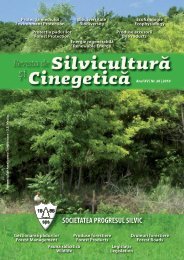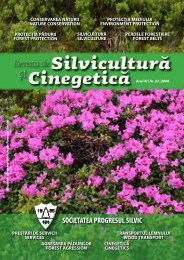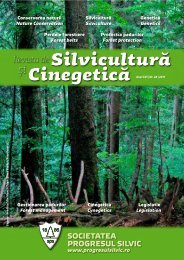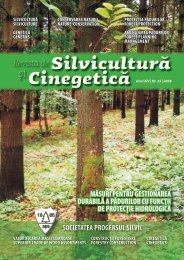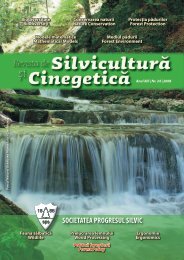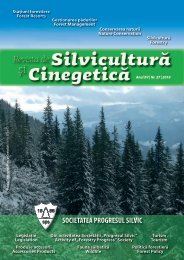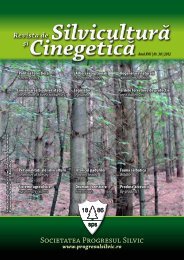Silviculture and Cinegetics Review - Societatea Progresul Silvic
Silviculture and Cinegetics Review - Societatea Progresul Silvic
Silviculture and Cinegetics Review - Societatea Progresul Silvic
You also want an ePaper? Increase the reach of your titles
YUMPU automatically turns print PDFs into web optimized ePapers that Google loves.
FORESTRY BELTS SILVICULTURE AND CINEGETICS REVIEW XVII/30/2012<br />
Agroforestry systems<br />
Mihăilă Elena, Costăchescu Corneliu, Dănescu Florin<br />
1. Introduction<br />
Although agroforestry systems refer to widespread<br />
<strong>and</strong> long applied practices, the science, the research<br />
regarding this is relatively new, the main boost being<br />
given by the presentation in 1977 of the study "Trees,<br />
food <strong>and</strong> people" by JG Bene, H.W. Beall <strong>and</strong> A.<br />
Cote, which emphasized the importance of research<br />
for improving agroforestry systems. A first <strong>and</strong><br />
immediate result of the debate on this research was<br />
the establishment of the International Council for<br />
Research on Agroforestry Systems (ICRAF), based in<br />
Nairobi, Kenya (MacDicken <strong>and</strong> Vergara, 1990).<br />
Specifically, agroforestry systems include all l<strong>and</strong> use<br />
systems in which forest species are deliberately<br />
maintained or introduced into agricultural or livestock<br />
production to benefit from the environmental <strong>and</strong><br />
economic interaction result. It is therefore a broad<br />
concept, which includes all forms of association<br />
between trees <strong>and</strong> / or shrubs, on the one h<strong>and</strong>, <strong>and</strong><br />
crops <strong>and</strong> / or animals, on the other h<strong>and</strong>.<br />
Agroforestry systems integrate trees with different<br />
crops <strong>and</strong> / or animals, with the main objective to<br />
reduce the possibility of certain risks (desertification,<br />
l<strong>and</strong> degradation, etc.) <strong>and</strong> to increase total<br />
production. Increased production (predictable) is a<br />
major goal for rural developers, but it is not the only<br />
expected benefit of agroforestry systems.<br />
In our country, the term agroforestry systems is a new<br />
concept, <strong>and</strong> often used with partial <strong>and</strong> inconclusive<br />
meaning, although the association of trees <strong>and</strong> / or<br />
shrubs with agricultural crops, pastures, animals has<br />
been practiced for a long time <strong>and</strong> in different ways.<br />
Associating components from different areas (forestry<br />
<strong>and</strong> agriculture) an interdisciplinary field is being<br />
shaped, divided equally between foresters <strong>and</strong><br />
agronomists. Thus, agroforestry systems must be<br />
analyzed each time, in two senses. The main purpose<br />
for which such agroforestry systems are established is<br />
getting additional productivity, diversified, of quality,<br />
<strong>and</strong> in terms of ensuring a high environmental <strong>and</strong><br />
economic stability. The interest shown is due to the<br />
effects of climate change <strong>and</strong> the degradation of<br />
ecosystems, agroforestry systems ensuring long-term<br />
increase of environmental quality <strong>and</strong> conservation of<br />
natural resources. In short term, they can maintain<br />
balance <strong>and</strong> ecosystem functionality, may increase<br />
their diversity, can mitigate greenhouse gas (by<br />
storing carbon) <strong>and</strong> have favorable socio-economic<br />
effects (providing jobs, varied production <strong>and</strong> of<br />
quality etc.).<br />
Therefore, in the current context agroforestry systems<br />
are not intended to replace stable, specialized <strong>and</strong><br />
productive systems, but to improve those undergoing<br />
degradation, unstable, in areas affected by drought,<br />
aridity etc. By integrating trees into agricultural<br />
systems it is ensured a more efficient use of light,<br />
water <strong>and</strong> nutrients than is generally possible in pure<br />
crops.<br />
Although the experience of other countries in the<br />
adoption of agroforestry systems cannot be accepted a<br />
priori, although the benefits of the association of<br />
forest <strong>and</strong> agricultural crops are evident, they may be<br />
at least a boost in the application of certain types of<br />
agroforestry systems in our country.<br />
2. Possibilities of associating forest<br />
vegetation with agricultural crops <strong>and</strong> /<br />
or animals<br />
In agroforestry systems there are three categories of<br />
items or components: woody species (trees <strong>and</strong><br />
shrubs), herbaceous species (crops <strong>and</strong> forage<br />
species) <strong>and</strong> animals. In any agroforestry system there<br />
must be the forest component (woody species - trees,<br />
bushes), without which there is no discussion about<br />
an agroforestry system.<br />
Forest vegetation association with agricultural crops<br />
<strong>and</strong> / or animals shall be different resulting in various<br />
agroforestry systems that can be classified in different<br />
ways. The main feature of agroforestry systems is that<br />
the combination of components is made<br />
simultaneously on the same field (Fig. 1).<br />
62



